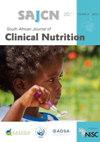Be active: a food-based dietary guideline for elderly South Africans
IF 0.6
Q4 NUTRITION & DIETETICS
引用次数: 0
Abstract
The goal of this paper is to support the ‘Be active!’ food-based dietary guideline (FBDG) for South Africans of seven years and older by means of a technical guideline regarding physical activity (PA) specifically for the elderly. Optimal nutrition and physical activity (PA) are essential to ensure healthy ageing. PA is an integral part of a healthy lifestyle; however; the rate of low PA in the elderly (59.7%) is high in South Africa (SA). Regular PA reduces the risks of chronic diseases, such as diabetes, high blood pressure, heart diseases and cancers. Therefore, this review study aims to gather available information concerning PA and suitable methods to promote PA among the elderly in SA. Lack of environmental support for PA, trainers, PA-educated caregivers, poor knowledge about the recommended level of PA and its benefits, lack of motivation by healthcare providers, poor health and nutritional status, and lack of opportunity for social engagement prevent the elderly from participating in PA. Elderly individuals without any physical challenges should participate in at least 150 minutes of moderate-intensity aerobic PA in a week, or at least 75 minutes per week of vigorous-intensity aerobic PA or an equivalent combination of both types of aerobic PA. It is better to start PA slowly and increase the duration and frequency gradually. Even those who have some disease limitations should try to change their status from ‘inactive or no activity’ to ‘some level of activity’ to enjoy the health benefits of PA. More research and programmes focusing on promotion of PA need to be implemented in order to improve PA among the elderly in SA.积极活动:南非老年人饮食指南
本文的目的是支持“积极!”通过专门针对老年人的身体活动技术指南,为7岁及以上的南非人制定了以食物为基础的膳食指南。最佳营养和身体活动(PA)对于确保健康老龄化至关重要。PA是健康生活方式的一个组成部分;然而;南非老年人低PA率(59.7%)较高。定期服用PA可降低患糖尿病、高血压、心脏病和癌症等慢性疾病的风险。因此,本综述研究的目的是收集有关PA的现有信息,以及在SA老年人中促进PA的合适方法。缺乏对PA的环境支持、培训师、受过PA教育的护理人员、对PA推荐水平及其益处的了解不足、医疗保健提供者缺乏动力、健康和营养状况不佳以及缺乏社会参与机会,这些都阻碍了老年人参与PA。没有任何身体挑战的老年人每周应参加至少150分钟的中等强度有氧PA,或每周至少75分钟的高强度有氧PA或两种有氧PA的等效组合。最好缓慢启动PA,并逐渐增加持续时间和频率。即使那些有一些疾病限制的人也应该尝试将他们的状态从“不活动或不活动”改变为“一定程度的活动”,以享受PA的健康益处。为了改善南澳老年人的养老状况,需要实施更多的研究和计划,重点是促进养老。
本文章由计算机程序翻译,如有差异,请以英文原文为准。
求助全文
约1分钟内获得全文
求助全文
来源期刊

South African Journal of Clinical Nutrition
NUTRITION & DIETETICS-
CiteScore
2.50
自引率
9.10%
发文量
21
期刊介绍:
1.The Journal accepts articles from all basic and applied areas of dietetics and human nutrition, including clinical nutrition, community nutrition, food science, food policy, food service management, nutrition policy and public health nutrition. 2.The Journal has a broad interpretation of the field of nutrition and recognizes that there are many factors that determine nutritional status and that need to be the subject of scientific investigation and reported in the Journal. 3.The Journal seeks to serve a broad readership and to provide information that will be useful to the scientific community, the academic community, government and non-government stakeholders in the nutrition field, policy makers and industry.
 求助内容:
求助内容: 应助结果提醒方式:
应助结果提醒方式:


